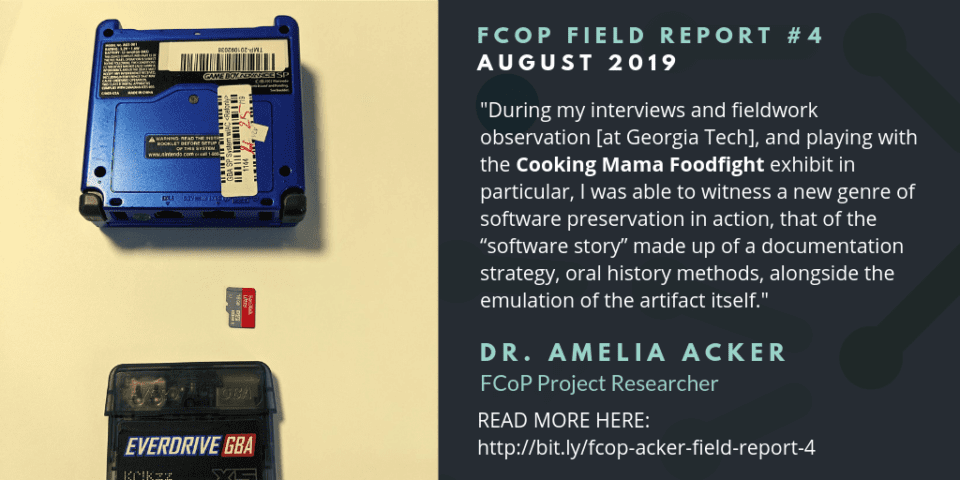FCoP Reflections Blog Post Series:
In our last STACKTRACE update, we announced the kick-off of the FCoP Reflections Blog Post Series running August through May 2020 (the end of the FCoP grant). We are excited to share our first two posts:
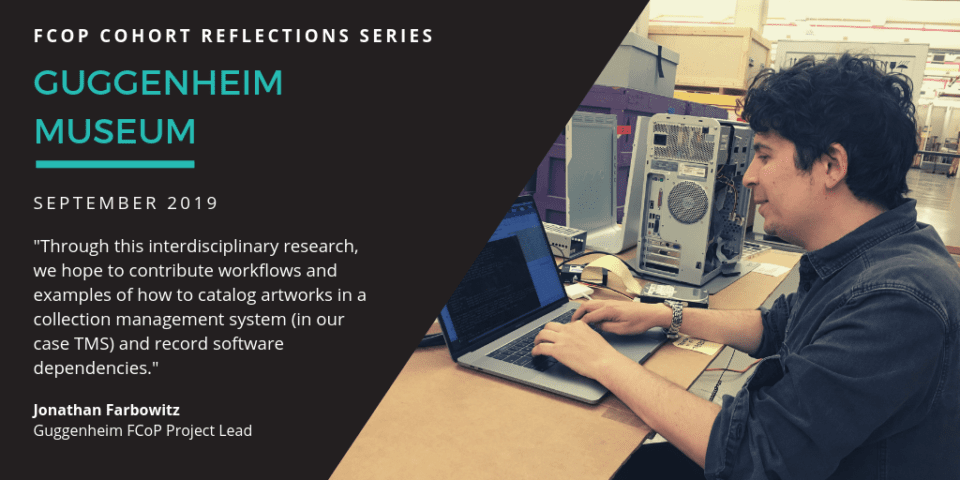
Jonathan Farbowitz of Guggenheim Museum kicked off the series by writing about the range of technology used in the museum’s computer-based artwork, disk imaging workflows, and metadata cataloging for hardware/software.
Read the full post on the FCoP blog.
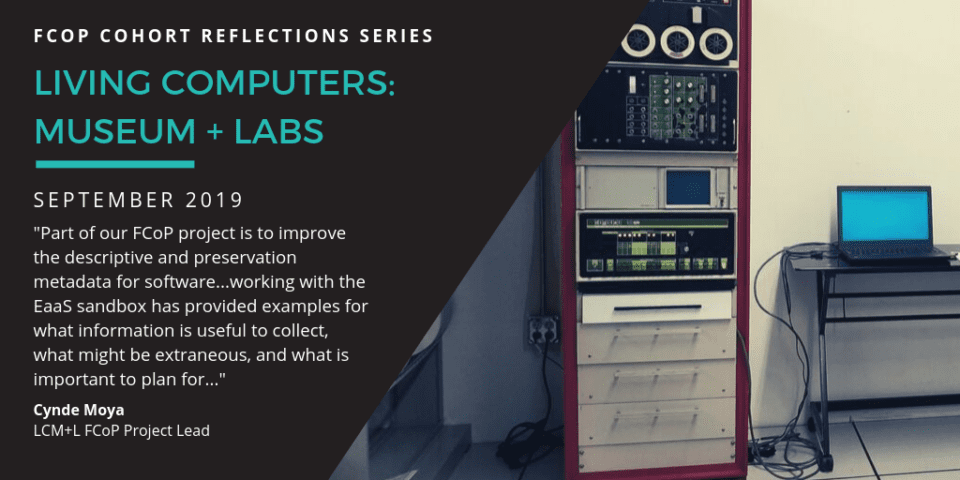
Cynde Moya of Living Computers Museum + Labs writes about emulating the Middle Ages of computing over regular internet speeds, testing disk images with EaaSI, and metadata for software and emulation environments.
Read the full post on the FCoP blog.
SAA Pop-Up recap
As previewed in the last STACKTRACE, Lauren Work (University of Virginia) and Tracy Popp (University of Illinois) teamed up to facilitate a pop-up session at the 2019 Society of American Archivists annual meeting in Austin, TX. The session, titled “How Does It Really Work? Software Preservation and Emulation in the Archives” was unique amongst this year’s SAA’s program offerings and was very well-received. Lauren and Tracy introduced attendees to the great work of the project and provided important comparisons of their respective cataloging approaches and curatorial frameworks.
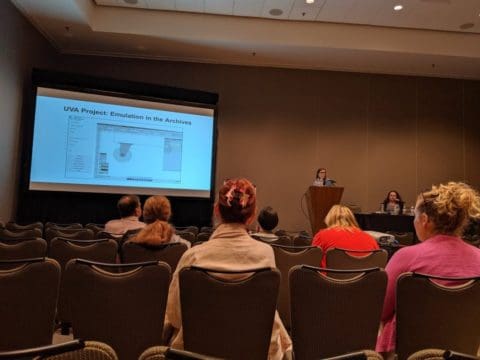
The SAA pop-up session followed on the heels of the Emulation in the Archives Workshop held at the University of Virginia in July. That event was detailed in the last issue of STACKTRACE, but you can also read all about it in BloggERS, from workshop attendee Brenna Edwards, Digital Project Archivist at Emory University: (https://saaers.wordpress.com/2019/09/10/recap-emulation-in-the-archives-workshop-uva-july-18-2019/).
Documentation and Imaging at University of Arizona
Monique Lassere (University of Arizona) has been working on documenting how videogame software from the Learning Games Initiative Research Archive (LGIRA) is cataloged and described, and how those practices will fit into the LGIRA’s overall workflow. With over 15,000 software titles in a geographically distributed archive, Lassere and the Arizona team (which includes LGIRA co-directors Ken McAllister and Judd Ruggill), this kind of documentation may prove to be useful for other archivists. In other workflow news at Arizona, Lassere and the Arizona team acquired a Commodore 64, other related hardware systems, that Monique hopes will allow them to forensically image C64-dependent software and games.
Videos as Documentation & Outreach
Jonathan Farbowitz (Guggenheim Museum) has been testing the emulation of a Mac Powerbook-era artwork, and, to facilitate the contextualization necessary for emulated artwork, he has created video documentation of the artwork running on a Powerbook 280c, and video documentation of the artwork running in the Basilisk II emulator. The videos provide helpful comparisons for any differences in speed and refresh rates. Farbowitz also noted down the Basilisk settings. You can read and listen to more about Jonathan and the Guggenheim’s great work on the project blog here.
Meanwhile, at the Living Computers Museum + Labs, Cynde Moya has been live streaming some of her emulation tests on Twitch, including an emulation of Storyspace, an early software used to create and read “hypertext” fiction. That video, which features a quick demonstration of Michael Joyce’s 1987 hypertext fiction “afternoon, a love story,” is also available now on YouTube.
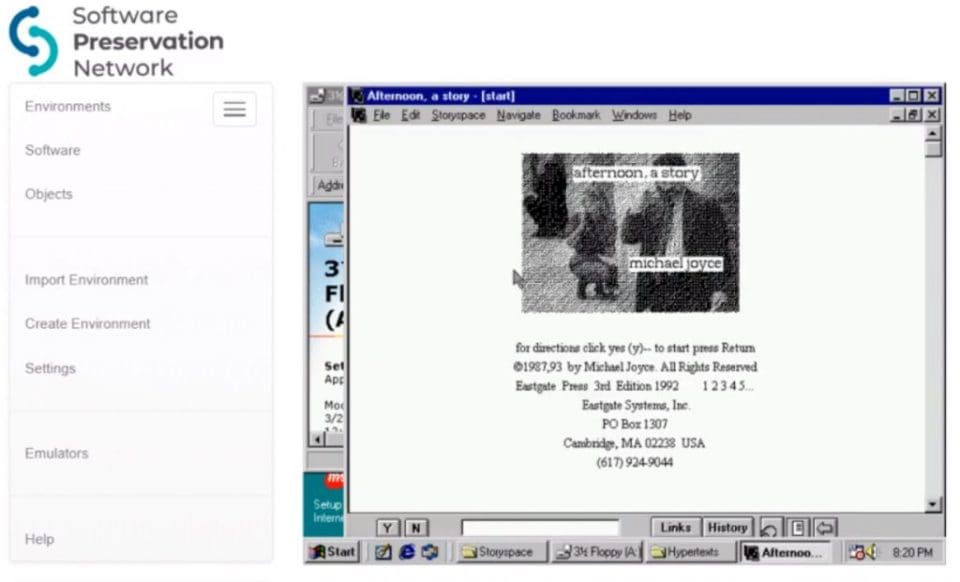
Big Ten Academic Alliance Digital Preservation peer group
Tracy Popp, as an archivist working at the University of Illinois, was able to attend a meeting of the Big Ten Academic Alliance Digital Preservation peer group in early September. There she presented about her work in FCoP, and received some valuable feedback from the group that may help inform deliverables that come out of the FCoP project as a whole:
- What level of IT expertise is required to engage with emulation?
- How much time/effort is required to curate content to prepare for emulation?
- When would one decide to use emulation?
- Concerns related to copyright/licensing (here Tracy referred her colleagues to the SPN-affiliated ARL Code of Best Practices in Fair Use for Software Preservation)
- Strong interest expressed in exporting files from the emulation environment
- Strong interest in creating a workflow for providing access to software-dependent content supplemental to texts.
- Interest in Flash/Shockwave application preservation and using emulation as an access method for rendering.The last point reminding us of those recent Chrome browser announcements about Flash support (finally) reaching end-of-life in December 2020!
The last point reminding us of those recent Chrome browser announcements about Flash support (finally) reaching end-of-life in December 2020!
The Year Ahead
The FCoP project is shifting into its final year of documentation and outreach. In order to capture all of the great work that the Cohort sites have accomplished, the project has brought on former Educopia staff member and digital preservationist, Matt Schultz, to assist with a bit of a gap analysis for the project.
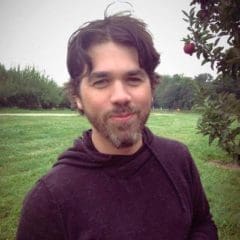
As he explains:
“Each of the Cohort partners have reached varying stages of completion toward their initial project goals. In nearly every case, individual project plans have had to be slightly revised, scope of deliverables refined, and timelines adjusted. Though it has been a stretch, the Cohort partners are entering this documentation and report-out phase with ample lessons-learned and milestones achieved. By seeing what has been accomplished and what remains outstanding, final priorities can be set and activities coordinated across all of the various roles and actors.
I am thrilled to be invited to come alongside the work of the FCoP community. I’ve got a long history with the Educopia team and have been a vocal cheerleader for all of the amazing programs that have coordinated with them since my time with MetaArchive. The Software Preservation Network and the Fostering Communities of Practice (FCoP) Project are doing some of the most innovative work in the digital preservation field at the present time. It’s a privilege to be a part of it.”
The FCoP project is scheduled to conclude in May 2020, and is on-track to lay a solid foundation for further work at each of the Cohort sites, as well as contribute a wide range of new best practices resources for the broader emerging field of software preservation.
Field Report #4 by Dr. Amelia Acker
In Dr. Acker’s fourth field report, she describes her visit to Georgia Tech where she shadowed FCoP Project Lead Wendy Hagenmaier, experienced the “Cooking Mama Food Fight Game Boy Advance” exhibit, and witnessed a new genre of software preservation in action.
